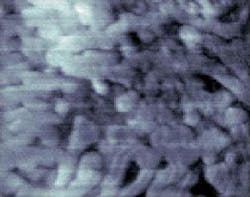MICROSCOPY: Atomic-force microscope can watch paint dry
A new video-rate atomic-force microscope (AFM) developed at Infinitesima (Oxford, England) can display images of molecular processes as they happen. The system allows imaging rates up to 1000 times faster than that of conventional AFMs, delivering full video at frame rates of 25 frames per second. The tool views areas of 3 × 3 µm, with the viewing area scanned across a surface in real time, and has a spatial resolution of tens of nanometers (similar to other AFMs), and millisecond temporal resolution.
The time it takes to acquire an image in an AFM is limited by three factors: the measurement bandwidth of the local interaction between the scanning-probe tip and sample, the rate at which the tip can scan the surface of the sample in an x-y plane, and how quickly the tip can follow the contours of the sample. These limits have been addressed by miniaturizing the microcantilever and constructing lower-mass scanners. This approach has achieved image acquisition rates of 12 frames per second, but is limited to imaging small areas of 250 × 250 nm. Other approaches have been tried, including adding a piezoelectric actuator to the AFM cantilever, but they too have limitations.
The design of the new tool takes a different approach that the company claims is not limited by the same constraints as previous approaches. The technology aims to solve two fundamental barriers. First, a microresonant scanner is used to raster the sample relative to the tip; the scanner uses rather than avoids mechanical resonances that limit a conventional scanner. Second, a mechanical feedback loop that is intrinsic to the microcantilever beam, instead of an electronic feedback loop, is used to control the tip-sample interaction and follow contours in the surface of the sample. An additional direct force is applied to the end of the cantilever, forcing the tip to maintain contact with the surface. By tuning the magnitude of the direct force and the degree of damping of the cantilever, a high-bandwidth passive feedback loop is created. The sample is mounted on a quartz-crystal resonator that generates the fast scan axis and is driven in the orthogonal scan axis by a piezoelectric actuator.
The rapid scanning of the stylus tip over the surface, moving at speeds of greater than 20 cm/s, has advantages beyond rapid imaging. Soft and delicate materials can be stably imaged with the high-speed tip because it is in contact with the sample for approximately one-thousandth of the time of a conventional AFM. Reducing the tip-sample interaction time reduces the probability of damaging the surface.
Researchers who use the new system will be able to view processes that were not previously observable. It is expected that this technology will enable the study of dynamic processes such as crystal growth and biotech processes, and will help spur growth in new areas in nanotechnology process development. The company is also looking at high-speed surface-scan analysis in the semiconductor and disk-drive markets.
Bridget Marx | Contributing Editor, UK
Bridget Marx was Contributing Editor, UK for Laser Focus World.
